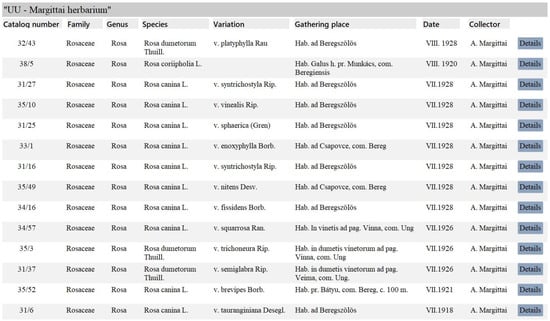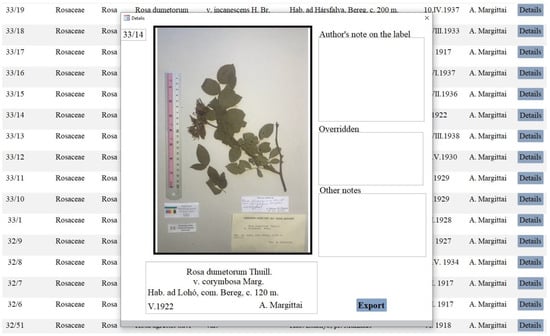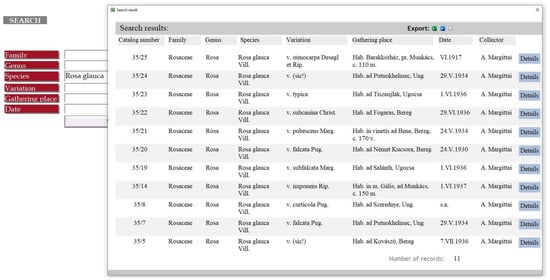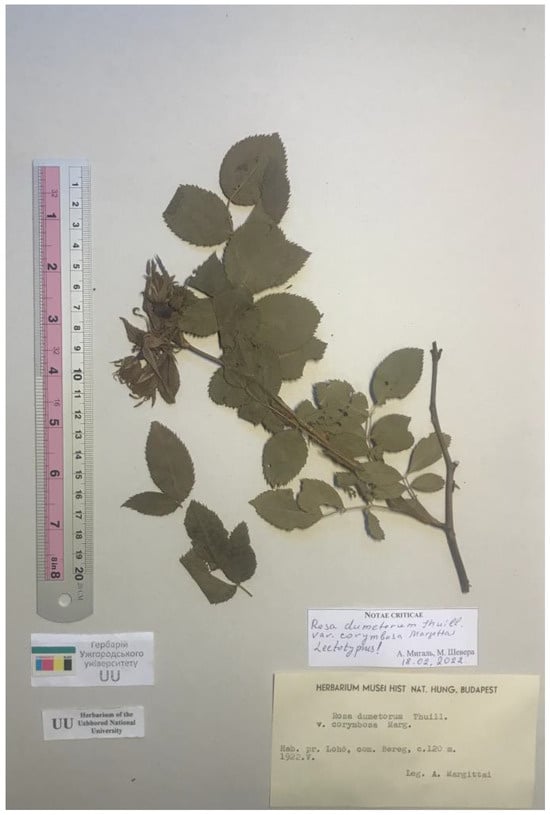Abstract
The digitization of herbarium collections guarantees a preservation and long-term use of scientifically valuable objects, e.g., wide and convenient access to these materials online and exchange between institutions. These are also important elements in the education and popularization of botanical knowledge. No less significant is the practical aspect of these studies due to the danger of these collections’ destruction as a result of Russian aggression—some of them have already been destroyed. The analyzed Margittai collection (1500 specimens) is kept at the Uzhhorod National University Herbarium (UU) and belongs to the historical and regional ones. This material is valuable because of its scientific, historical and cultural significance. By the initiative and thanks to the efforts of Prof. S. Fodor, the studied collection (most of which are doublet specimens) was transferred in 1965 from the Hungarian Natural History Museum (BP), where the main herbarium of the researcher is preserved (40,000 specimens), to the Uzhhorod State University. Due to the fact that the collection has not been studied, in 2021, the authors began a special investigation of this collection and assessment of its current state. The structure of the database has been developed, it is being filled, and the digitization of type materials has begun.
1. Introduction
Herbaria are reliable basic sources of information regarding the current state and historical changes in plant species traits and biotic interactions. Their main purpose is to provide a base for floristic and taxonomic research. The processing of a large array of herbarium data is a necessary condition for solving diverse scientific botanical questions. One of the modern trends of herbarium curation is the digitization of collections [,,,,,,,,,,,], which involves three processes: data entry, making digital images of specimens, and georeferencing. First of all, this guarantees the preservation and long-term use of scientifically valuable objects for identification, analysis and generalization of information. This is a part of global initiatives to create a wide network with information about biodiversity, provide wide and convenient access to these materials online, enhance exchange between institutions, etc. It is also an element of the educational process and popularization of botanical knowledge from anywhere in the world. No less important is the practical aspect of such research, in particular, the identification of taxa, analysis of morphological, chorological, ecological, sozological, molecular genetic features, etc. Such studies are especially relevant now for the conservation of scientific collections in Ukraine because some of them as well as other objects of cultural heritage were damaged during the aggression of the Russian Federation. In the leading universities and academic institutions of the world, special research and digitization are actively underway. First of all, it concerns historical collections, including specimen types and original materials. In Ukraine, e.g., in the Herbarium of M.G. Kholodny Institute of Botany, NAS of Ukraine (KW), Lviv State Museum of the NAS of Ukraine (LWS), Ivan Franko Lviv National University (LW), I.I. Mechnikov Odesa National University (MSUD), V.N. Karazin Kharkiv National University (CWU), etc., this work is also in progress [,,]. This is an extremely important study, because numerous small regional herbaria, which often contain important original scientific and historical botanical data, are overlooked by researchers due to their inaccessibility. Such an example would be a valuable Margittai collection in the Herbarium of the Uzhhorod National University (UU).
Aims. Our study was focused on the following: (a) describing the Margittai life path and scientific achievements, (b) inventorying of the Margittai collection in UU Herbarium and assessment of its current state; (c) a compilation of the electronic catalogue of the collection; (d) creating a database, formation of its structure and updating it, and (e) digitization of type specimens, as a priority.
2. Materials and Methods
The collection of Margittai in the Herbarium of the Uzhhorod National University (UU) is the object of special study. The research and analysis were carried out according to general floristic and systematics methods. Rejection of the relational model of the DB is primarily due to the absence of the need to perform complex queries and its significant size (scale). During the creation of the database, some recommendations were taken into account []. Digitization of the type and authentic specimens of the analyzed collection, as a priority, was carried out by authors using a Canon camera. The nomenclatural treatment and the lectotypification follow the International Code of Nomenclature for algae, fungi, and plants (Turland et al., 2018) []. The names of taxa are given according to original herbarium labels of the specimens, according to the author’s interpretation of its status. Only obvious mechanical errata were fixed. The acronyms of herbaria are given according to Thiers (2023 onwards) [].
Botanical information about different plant taxa from the UU Herbarium, including the Margittai collection, are widely used in floristic and taxonomic publications, which is confirmed by numerous critical notes in monographs. The analyzed collection is valuable due to its scientific, historical and cultural significance. This collection belongs to the regional, historical ones. During 2021–2023, the authors started a special study of the Margittai collection in the UU Herbarium, its inventorization, critical analyzing and summarizing, and assessing the state of its preservation. We studied the species composition of the collection. A search for type specimens and their typification was carried out. The database structure has been developed and filled with relevant information, and digitization of the type material of collection has begun. In this short communication, we present the preliminary results of our investigation.
3. Results
Antony Margittai (1880–1939): Life Path and Scientific Achievements
Margittai was born in the Palanok village in Austro-Hungary (now Mukachevo, Ukraine). He studied at the Mukachevo gymnasium and at the faculty of philosophy of the Budapest University (now Eötvös Loránd University), specializing in physics and mathematics. As a teacher, he taught mathematics, physics, chemistry and natural history at the monastery school, gymnasiums in Turchanske Teplice (now belonging to Slovakia) and Mukachevo. He started as an amateur botanist, who became one of the outstanding connoisseurs of the Transcarpathian flora before the middle of the 20th century. Together with Hungarian and Czech-Slovak botanists (e.g., A. Boros (1900–1973), K. Domin (1882–1953) and others), they carried out joint field trips for floristic research. The scientific heritage of the researcher includes the following: (a) scientific publications on systematics, floristics and ethnobotany, including the first part of «Vznosy k flore Podkarpatskei Rusi» [«Supplements to the flora of Podkarpatska Rus»] in 1923; (b) new taxa described in genera Carduus L., Centaurea L., Elatine L., Rosa L., etc., including from the territory of Ukraine, e.g., Centaurea ×breeziness J. Wagner et Margittai, C. ×beskidiana J. Wagner et Margittai, C. ×munkacsensis J. Wagner et Margittai, Rubus munkacsensis Gayer et Margittai, 1930, etc.; (c) about 50,000 herbarium specimens, the main fund (about 40,000) is kept in the Hungarian Natural History Museum (BP), (doublet samples are in many world Herbariums, e.g., in B, BR, BRA, BRNU, CHER, CLU, DAO, E, GR, GZU, IBSC, KRA, KW, LIM, LW, M, MPU, NI, PH, PRC, PR, SIB, SO, UBC, ULM, UU, W, WA, WU, Z + ZT, etc., including part in the preparation of Flora Hungarica exsiccate, Flora Exsiccata Reipublicae Bohemicae Slovenicae, Flora Cechoslovenica exsiccate, Plantae Exsiccatae Carpatorum ([,,]; e.g., http://indexs.botanischestaatssammlung.de/, accessed on 15 February 2023). The analyzed collection was transferred to the UU Herbarium due to the initiative and direct participation of S. Fodor (1907–2000), professor of the Uzhhorod State University, who was a student of Margittai at the Mukachevo gymnasium. In 1965, at the 20th anniversary of the founding of the Uzhhorod State University (now Uzhhorod National University), the Hungarian Natural History Museum transferred the mainly doublets of herbarium specimens for the University, which was confirmed by archival documents stored in the museum. In the Herbarium handbooks devoted to the UU Herbarium [,], this collection is marked as valuable and it contains about two thousand doublet samples. Unfortunately, until recently, no special research and analysis of this relatively small and interesting, regionally valuable collection was carried out.
As a result of the research, it was established that the Margittai collection in the UU Herbarium contains 1500 herbarium specimens representing 581 species and intraspecific taxa of vascular plants of 216 genera and 53 families. Almost all taxa were collected in Zakarpats’ka Oblast’ (Transcarpathia Region) of Ukraine and only several ones were in the adjacent territory (now Hungary and Slovakia). It was established that the majority of specimens were collected by Margittai, and some were collected by other Hungarian and Slovakian collectors. The period of formation of the collection covers 1908–1938. The preservation of the collection is generally good, which is explained by high-quality herbarization with compliance with all its rules, but the color of the flowers of some of the plants has naturally changed.
The scientific value of the analyzed collection will be primarily in the qualitative documentation of the floristic diversity of the studied territories by Margittai. The specimens of the collection represent not only a significant part of the species richness of the regional flora recorded at that time but also a large number of varieties and forms determined by the scientists, e.g., Asplenium trichomanes L. var. glandulosum Podp., Carex pallescens L. var. typica Asch. et Graebn., C. pallescens L. var. elatior Asch. et Graebn., Rosa canina L. var. bihariensis Borb., R. dumetorum Thuill. var. subdacica Borb. etc., Carex gracilis Curt. f. personata Kück, C. oederi Retz. f. pygmaea Andr., Poa trivialis L. f. effusa Asch. et Graeb., etc. [].
Initially, some researchers, including the authors, compiled a paper index of the Margittai collection in UU herbarium. As a first stage of the special study, an electronic catalogue of the analyzed collection was compiled, which became the basis for developing the database. It contains information from herbarium labels as well as those made by original author and information printed later by a technician, and base characteristics of the taxa, such as the name of the ones according to the original status interpretation by author, geography and ecology, date and collector. Interested researchers can obtain any information about a specific taxon from this collection by requesting the curator of UU Herbarium (V. Sabadosh).
The processing of information from herbarium specimens, collected between 1908 and 1938 years, revealed many problematic aspects of their practical use today. In many cases, at least the nomenclature of taxa needs to be updated, as well as the revision of taxa, and the identification of the localitets of species (because sometimes, names of geographical locations are obsolete and have not been used for a long time, and there are also misspellings of these names). This work requires additional time and effort. Database and especially digitization of the collection will significantly expand the possibilities of involving scientists who are interested in its processing.
The next stages of the study of the analyzed collection were connected with a development of the database structure (Figure 1 and Figure 2), which contains the following elements:

Figure 1.
A fragment of database of the Margittai collection in UU Herbarium.

Figure 2.
A fragment of database of the Margittai collection in UU Herbarium with digital images of specimen.
- Main table with data;
- Forms for entering and editing information in the table;
- Forms for viewing reports on requests for digitized herbarium specimens.
The DB is presented in the Excel table form with different information. The table contains 12 fields: internal code (catalogue number), names of family, genus, species, variety, locality, date, collectors, author’s notes on the label, revision of taxa, other notes, and field for attachment. Adding photos of herbarium specimens was carried out using the «Attachment» field. For the user, the work with the database starts with the search engine. The search system is built on the basis of constantly executed queries, the selection criterion of which is a part of the phrase entered into separate search fields using a special form. At the same time, the system searches for matches in all available fields. Thus, the search is narrowed as the search fields are filled. At the output, the search engine issues a report with the search results, which is structured in the form of a table with a list of herbarium specimens. Clicking the «details» button opens a form for viewing a specific herbarium specimen, which contains its original photo and metadata. The search result and metadata of individual herbarium specimens can be exported to the most convenient xls, csv, doc file formats. To enter new data into the database or edit existing data, a corresponding form has been created, which is connected to all the fields of the main table, where, for the convenience of robots, there are separate fields for entering data directly by keyboard, and there are fields with drop-down lists (for categorical (grouped) data). This approach will ensure the speed of entering or editing data as well as minimize the possibility of input errors (Figure 3).

Figure 3.
A fragment of database of the Margittai collection in UU Herbarium with possibility of search.
The next stage of the work is the start of the digitization of specimens. In the analyzed collection, the most valuable are type and authentic specimens of the taxa described by Margittai. During the study, we found type specimens, e.g., lectotype of Leontodon vagneri A. Marg. and Rosa dumetorum Thuill. var. corymbosa A. Marg. (Figure 4), which is absent in BP Herbarium, and also several isotypes of infraspecies taxa of Rosa sp. div. Their typification was carried out first of all (the manuscript of publication has being prepared). Type specimens described from the Ukrainian flora have already been digitized by camera.

Figure 4.
Lectotype of Rosa dumetorum Thuill. var. corymbosa A. Marg. in the UU Herbarium.
In the near future, there are plans to digitize these specimens by appropriate high-resolution equipment (there is a prior agreement with the V.N. Karazin Kharkiv National University where there is a herbarium scan) and further presentation of digitized samples on the GBIF platform. It will be available for further research by any scientist around the world.
The majority of taxa of the analyzed collection belongs to the natural fraction of the Transcarpathian flora. Typical Central European species are presented here, some of which are rare due to human influence that significantly reduced their range and populations. They are currently included in the Red List of Transcarpathia [] and the Red Data Book of Ukraine []: for example, Crocus heuffelianus Herb., some species of the Orchidaceae family, Potentilla alba L., P. palustris (L.) Scop., Soldanella hungarica Simonk., Typha schuttleworthii Koch et Song., Vitis sylvestris C.C. Gmail., etc. Alien species of the collection are also valuable. They recorded by the researcher in the region during the study, first of all kenophytes: Aster annuus L., Bromus commutatus Schrad., Solidago serotina Ait. etc. and archaeophytes. Some of them are invasive in the region. The digitization of specimens of this group and common species of Transcarpathian flora are currently still in progress because of limited financial resources and technical facilities.
4. Conclusions
At the initial stages of the digitization of the Margittai collection in UU Herbarium, a simple database structure was used. The connections in the database are reduced to the First normal form (1NF); this is due to the lack of ability to support complex voluminous queries and the relatively small size of the data set itself as well as improvement in the data structure. Nevertheless, the implemented structure of the database with available tools allows for high-quality and convenient access and familiarization with herbarium specimens and accompanying information. Compliance of the data structure with Darwin Core standards will be performed at the finalization stage of the project.
Currently, the analyzed collection database is localized on the institution’s PC. An additional task will be the adding information on the geographical location of each herbarium specimen with the provision of their visualization (presentation) in geographic information systems (GIS), expansion of the functionality of the search system, as well as the creation of tools for conducting various analytical operations. In the future, we plan to carry out work on adapting the developed DB for use in the Internet network. For this, DBMS Access has convenient methods for transferring databases to SQLServer and for sharing them.
Author Contributions
Conceptualization, M.V.S.; methodology, M.V.S., A.V.M., V.I.S. and V.I.R.; software, V.I.R.; validation, V.I.R. and A.V.M.; formal analysis, A.V.M., V.I.S. and V.I.R.; investigation, M.V.S., A.V.M., V.I.S. and V.I.R.; data curation, M.V.S., A.V.M., V.I.S. and V.I.R.; writing—original draft preparation, M.V.S.; writing—review and editing, M.V.S., A.V.M. and V.I.S.; visualization, V.I.R.; supervision, M.V.S. All authors have read and agreed to the published version of the manuscript.
Funding
This research received no external funding.
Institutional Review Board Statement
Not applicable.
Data Availability Statement
Data are contained within the article.
Acknowledgments
We are grateful to Bogdan Jackowiak (Adam Mickiewicz University, Poznan, Poland) for invitation to publish in the journal, Yuryi Gamulia (V.N. Karazin Kharkiv National University) for consultations, Olena Miskova (M.G. Kholodny Institute of Botany, NAS of Ukraine) for technical assistance, Yuryi Tykhonenko (the same institute) for style improvement, and the editorial team and anonymous reviewers for help and critical comments.
Conflicts of Interest
The authors declare no conflicts of interest.
References
- Schmidt, L. Digitization of Herbarium Specimens, a Collaborative Project. In Proceedings of the ACRL Thirteenth National Conference, Baltimore, MD, USA, 29 March–1 April 2007; p. 67. [Google Scholar]
- Molnár, A.V.; Takács, A.; Horváth, O.; Vojtkó, A.E.; Király, G.; Sonkoly, J.; Sulyok, J.; Sramkó, G. Herbarium Database of Hungarian Orchids I. Methodology, dataset, historical aspects and taxa. Biologia 2012, 67, 79–86. [Google Scholar] [CrossRef][Green Version]
- Soltis, P. Digitization of herbaria enables novel research. Am. J. Bot. 2017, 104, 12811284. [Google Scholar] [CrossRef] [PubMed]
- Nelson, G.; Ellis, S. The history and impact of digitization and digital data mobilization on biodiversity research. Philos. Trans. R. Soc. B 2018, 374, 20170391. [Google Scholar] [CrossRef] [PubMed]
- Heberling, J.M.; Prather, L.A.; Tonsor, S.J. The changing uses of herbarium data in an era of global change: An overview using automated content analysis. BioScience 2019, 69, 812–822. [Google Scholar] [CrossRef]
- Šegota, V.; Vilović, T.; Zovko, I. Orchid (Orchidaceae) diversity within Herbarium Croaticum (ZA) collection sensu stricto. Nat. Croat. 2019, 28, 325–343. [Google Scholar] [CrossRef]
- Heberling, J.M.; Miller, J.T.; Noesgaard, D.; Weingart, S.B.; Schigel, D. Data integration enables global biodiversity synthesis. Proc. Natl. Acad. Sci. USA 2021, 118, e2018093118. [Google Scholar] [CrossRef] [PubMed]
- Mentlik, J.; Cavallin, N. Royal Botanical Gardens Herbarium (HAM), Version 2.1; Royal Botanical Gardens Herbarium (HAM): Burlington, ON, Canada, 2022; Occurrence Dataset. [CrossRef]
- Jackowiak, B.; Celka, Z.; Szkudlarz, P. Digitalization and Open Access to the botanical and mycological collections of the Adam Mickiewicz University in Poznań (Poland). In Herbaria of the 21st Century: Achievements and Challenges, Proceedings of the International Scientific Conference Dedicated to the 100th Anniversary of the National Herbarium of Ukraine (KW)—The Herbarium of M.G. Kholodny Institute of Botany, NAS of Ukraine, Kyiv, Ukraine, 1 October 2021; M.G. Kholodny Institute of Botany, NAS of Ukraine: Kyiv, Ukraine, 2021; pp. 152–156. (In Ukrainian) [Google Scholar]
- Mandrioli, M. From Dormant Collections to Repositories for the Study of Habitat Changes: The Importance of Herbaria in Modern Life Sciences. Life 2023, 13, 2310. [Google Scholar] [CrossRef] [PubMed]
- Novikov, A.V.; Hushtan, H.H.; Hushtan, K.V.; Kuzyarin, O.T.; Leleka, D.Y.; Nachychko, V.O.; Prots, B.H.; Rizun, V.B.; Savytska, A.G.; Susulovska, S.A.; et al. Outlining the aims and format of the project «Digitisation of natural history collections damaged as a result of hostilities and related factors: Development of protocols and implementation based on the State Museum of Natural History of the National Academy of Sciences of Ukraine». Proc. State Nat. Hist. Mus. Lviv. 2023, 39, 19–30. (In Ukrainian) [Google Scholar] [CrossRef]
- Novikov, A.; Savytska, A.; Kuzyarin, O.; Nachychko, V.; Susulovska, S.; Rizun, V.; Susulovsky, A.; Hushtan, H.; Hushtan, K.; Leleka, D. Data mobilisation in the LWS Herbarium: Success and prospects. Biodivers. Data J. 2024, 12, e117292. [Google Scholar] [CrossRef] [PubMed]
- Tasenkevich, L.O.; Shiyan, N.M.; Khmil, T.S.; Mosyakin, S.L. Some aspects of Herbarium’s innovative activities in connection with the preservation and development of collections. In Herbaria of the 21st Century: Achievements and Challenges, Proceedings of the International Scientific Conference Dedicated to the 100th Anniversary of the National Herbarium of Ukraine (KW)—The Herbarium of M.G. Kholodny Institute of Botany, NAS of Ukraine, Kyiv, Ukraine, 1 October 2021; M.G. Kholodny Institute of Botany, NAS of Ukraine: Kyiv, Ukraine, 2021; pp. 86–93. (In Ukrainian) [Google Scholar]
- Anischenko, I.M.; Sytnik, K.M. Computerization of National Herbarium of Ukraine a priority and perspective steps. Ukr. Bot. J. 2007, 64, 634–642. (In Ukrainian) [Google Scholar]
- Turland, N.J.; Wiersema, J.H.; Barrie, F.R.; Greuter, W.; Hawksworth, D.L.; Herendeen, P.S.; Knapp, S.; Kusber, W.-H.; Li, D.-Z.; Marhold, K.; et al. (Eds.) International Code of Nomenclature for Algae, Fungi, and Plants (Shenzhen Code) Adopted by the Nineteenth International Botanical Congress, Shenzhen, China (July 2017); Regnum Vegetabile 159; Koeltz Botanical Books: Glashütten, Germany, 2018. [Google Scholar] [CrossRef]
- Thiers, B. Index Herbariorum: A Global Directory of Public Herbaria and Associated Staff. New York Botanical Garden’s Virtual Herbarium. New York. 2023. Available online: http://sweetgum.nybg.org/science/ih/ (accessed on 20 December 2023).
- Andrik, E.J.; Shevera, M.V.; Kish, R.Y.; Pifkó, D. In Commemoration of Antal Margittai (1880–1939) (devoted to the 130th anniversary since his birthday). In Bicentenary of Vegetation Cover Studies of the Carpathians, Proceedings of the International Scientific Conference Devoted to the 130th Anniversary Since Antal Margittai’s Birthday, Mukachevo-Beregovo, Ukraine, 16–18 September 2010; Karpaty Press: Uzhgorod, Ukraine, 2010; pp. 7–16. (In Ukrainian) [Google Scholar]
- Pifkó, D.; Lökös, L. Margittai’s scientific heritage in the Hungarian natural history museum. In commemoration of Antal Margittai (1880–1939) (devoted to the 130th anniversary since his birthday). In Bicentenary of Vegetation Cover Studies of the Carpathians, Proceedings of the International Scientific Conference Devoted to the 130th Anniversary Since Antal Margittai’s Birthday, Mukachevo-Beregovo, Ukraine, 16–18 September 2010; Karpaty Press: Uzhgorod, Ukraine, 2010; pp. 150–156. (In Ukrainian) [Google Scholar]
- Shevera, M.; Pifko, D.; Optasyuk, O. List of taxa described by Antal Margittai and lectotypification of his taxa deposited in the Hungarian natural history museum (BP). Stud. Bot. Hung. 2014, 44, 113–122. [Google Scholar] [CrossRef]
- Fodor, S.S. Herbarium of the Uzhhorod State University. In Herbaria of Ukraine; Institute of Botany, NAS of Ukraine: Kyiv, Ukraine, 1995; pp. 64–67. (In Ukrainian) [Google Scholar]
- Kish, R.Y. Herbarium of Uzhhorod National University. In Herbaria of Ukraine. Index Herbariorum Ucrainicum; Shyian, N.M., Ed.; Alterpress: Kyiv, Ukraine, 2011; pp. 276–279. (In Ukrainian) [Google Scholar]
- Mihaly, A.V.; Sabadosh, V.I.; Shevera, M.V. Herbarium of Uzhhorod National University (UU): Memorial collection of Antony Margittai. In Herbaria of the 21st Century: Achievements and Challenges, Proceedings of the International Scientific Conference Dedicated to the 100th Anniversary of the National Herbarium of Ukraine (KW)—The Herbarium of M.G. Kholodny Institute of Botany, NAS of Ukraine, Kyiv, Ukraine, 1 October 2021; M.G. Kholodny Institute of Botany, NAS of Ukraine: Kyiv, Ukraine, 2021; pp. 123–127. (In Ukrainian) [Google Scholar]
- Kricsfalusy, V.V.; Budnikov, G.B.; Mihaly, A.V. Red List of Transcarpathia: Plant Species and Plant Communities That Are under Threat of Extinction; Zakarpattia Press: Uzhhorod, Ukraine, 1999; 196p. (In Ukrainian) [Google Scholar]
- Didukh, Y.P. (Ed.) Red Data Book of Ukraine; Globalconsalting: Kyiv, Ukraine, 2009; 900p. (In Ukrainian) [Google Scholar]
Disclaimer/Publisher’s Note: The statements, opinions and data contained in all publications are solely those of the individual author(s) and contributor(s) and not of MDPI and/or the editor(s). MDPI and/or the editor(s) disclaim responsibility for any injury to people or property resulting from any ideas, methods, instructions or products referred to in the content. |
© 2024 by the authors. Licensee MDPI, Basel, Switzerland. This article is an open access article distributed under the terms and conditions of the Creative Commons Attribution (CC BY) license (https://creativecommons.org/licenses/by/4.0/).